Increasing Energy and Material Consumption Efficiency by Application of Material and Energy Flow Cost Accounting System (Case Study: Turbine Blade Production)
Abstract
1. Introduction
- Applying a new costing evaluation system in the power plant industry;
- Improving the efficiency of raw materials and energy usage by applying the MEFCA method in one of the country’s power plant repair companies;
- Saving energy and reducing costs by avoiding material losses and hidden costs of waste;
- Using engineering economics techniques and cash flow present value method in a long-term planning horizon.
2. Literature Review
3. Methodology
4. Results
- Planning horizons (here, 40 years with four-year time periods, for a total of 10);
- Determination of financial flows related to initial investment (II);
- Determination of the financial flows related to the equipment’s sacrificial value (SV);
- Determination of the cash flow of incomes (I);
- Determination of operating cost cash flow (OC);
- Calculation of cash flow before tax (CFBT);
- Depreciation calculation (D);
- Calculation of taxable income (TI);
- Tax calculation (T);
- Calculation of cash flow after tax (CFAT);
- Calculation of net present value of cash flow (NPV).
5. Conclusions
Author Contributions
Funding
Institutional Review Board Statement
Informed Consent Statement
Data Availability Statement
Conflicts of Interest
Appendix A
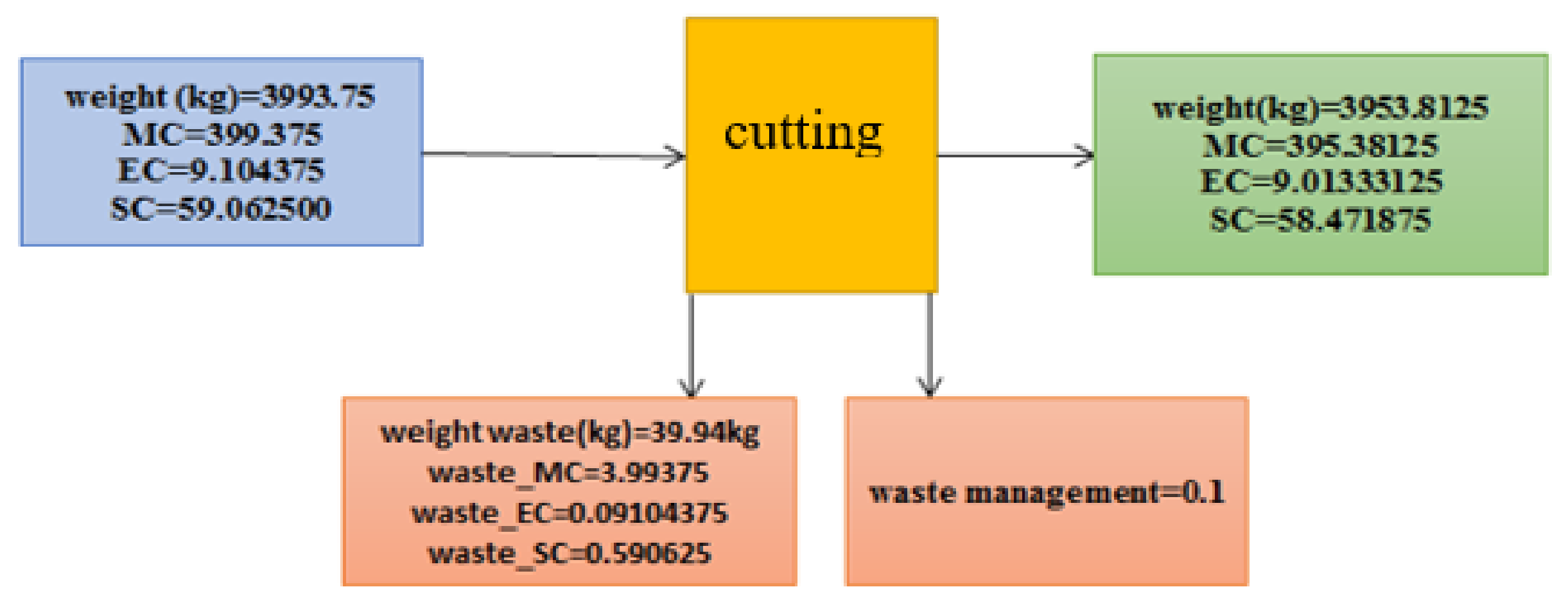
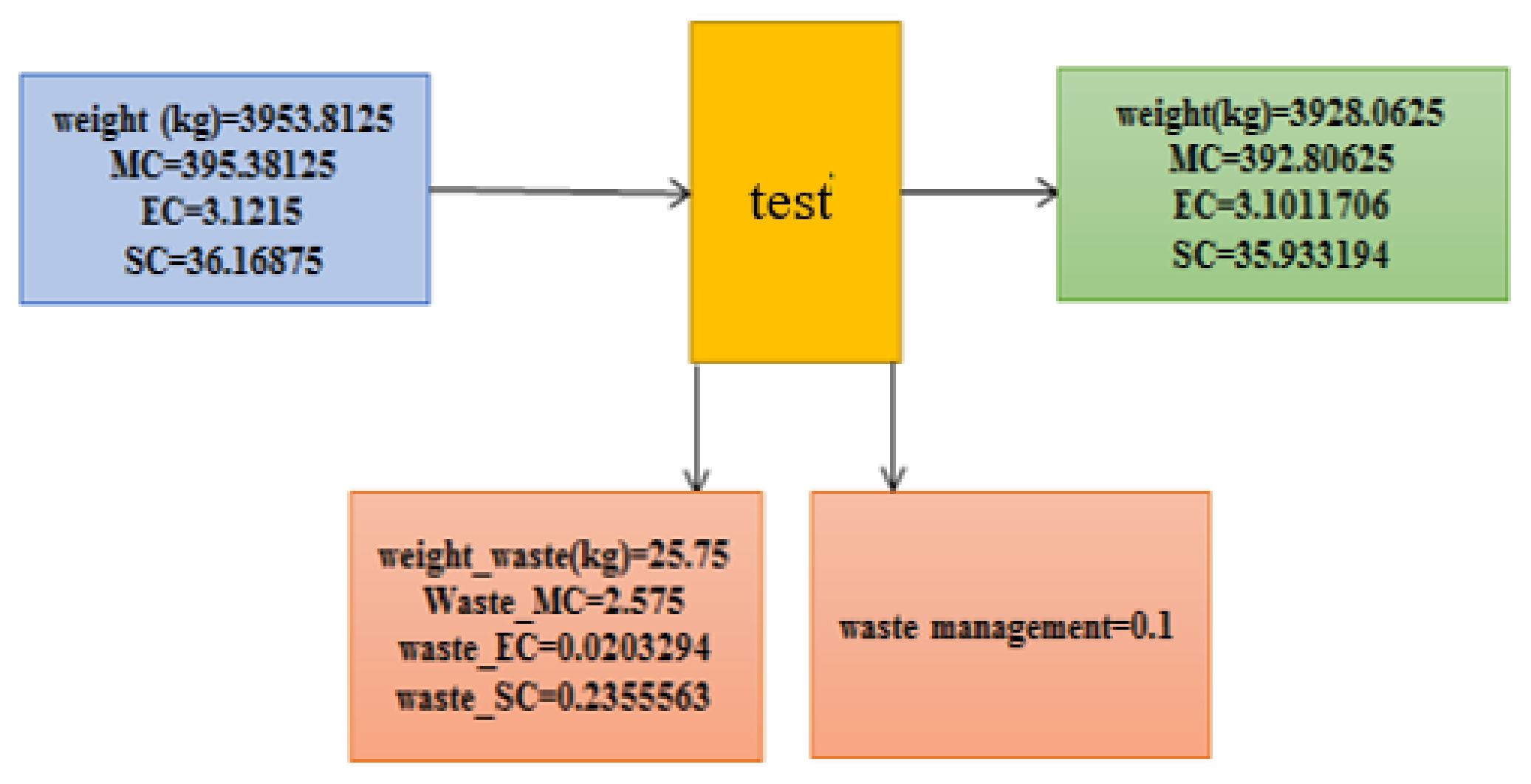


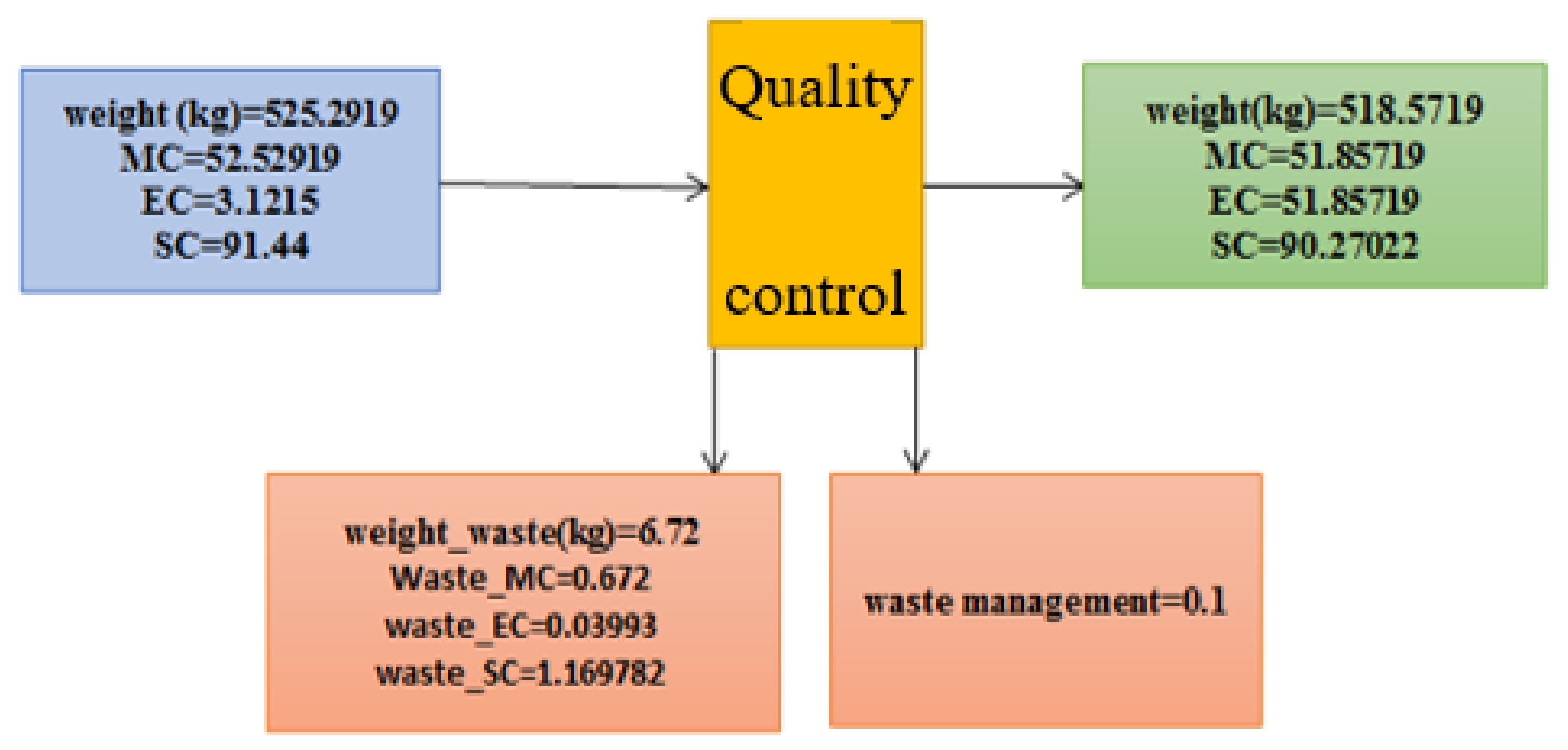
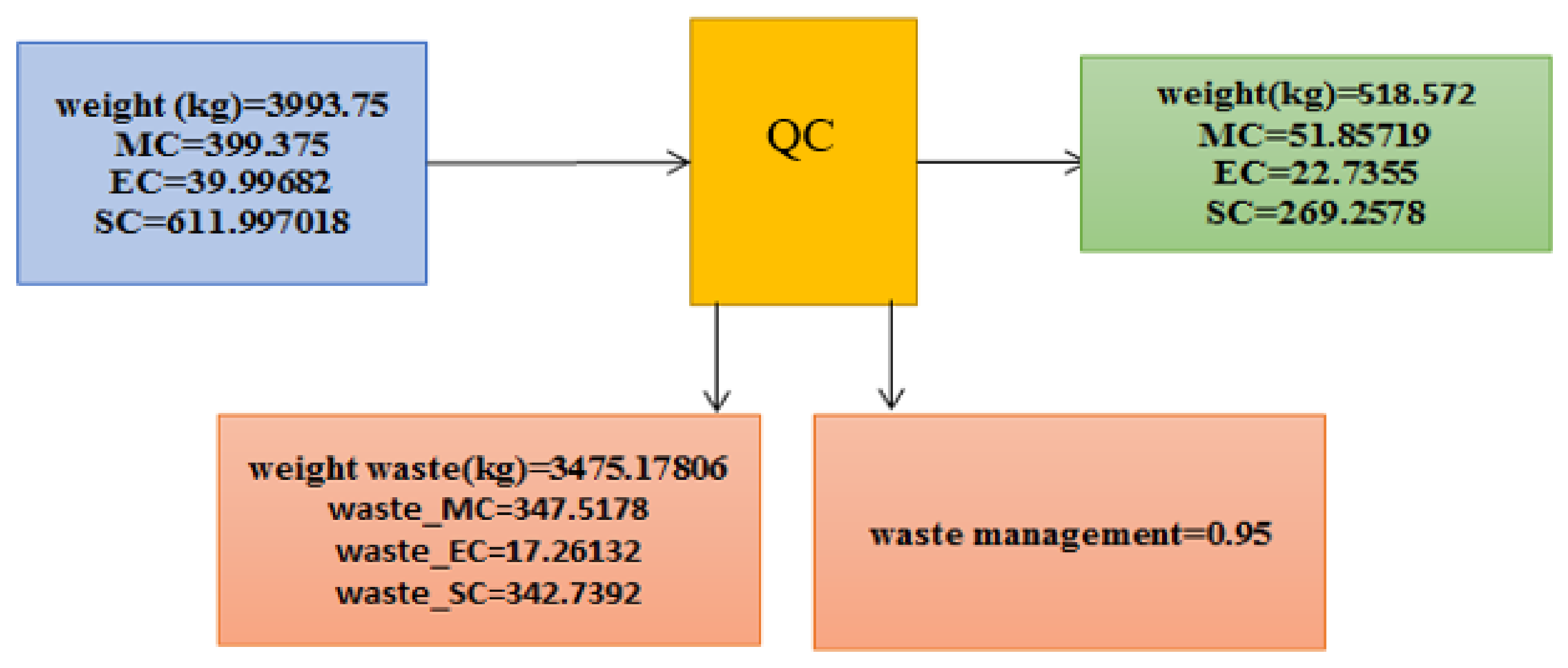
Appendix B
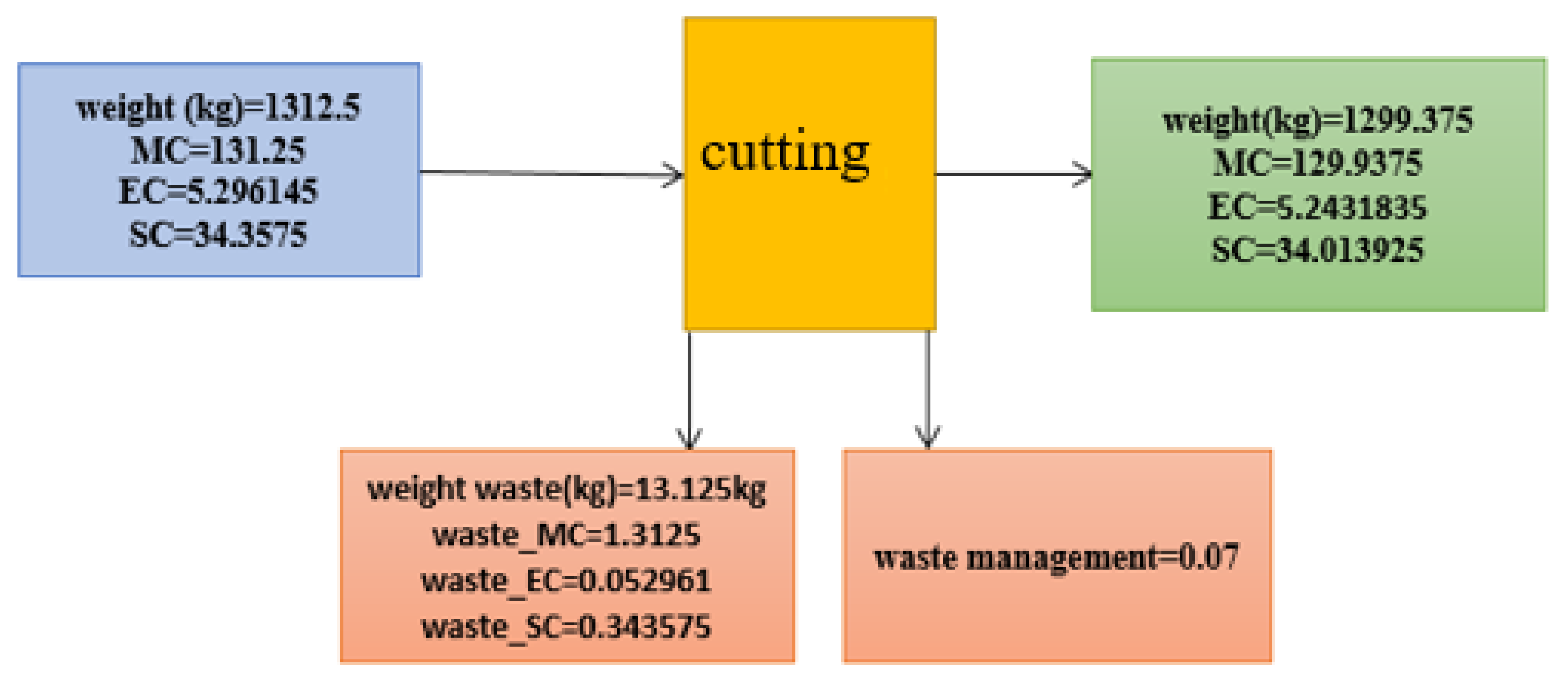
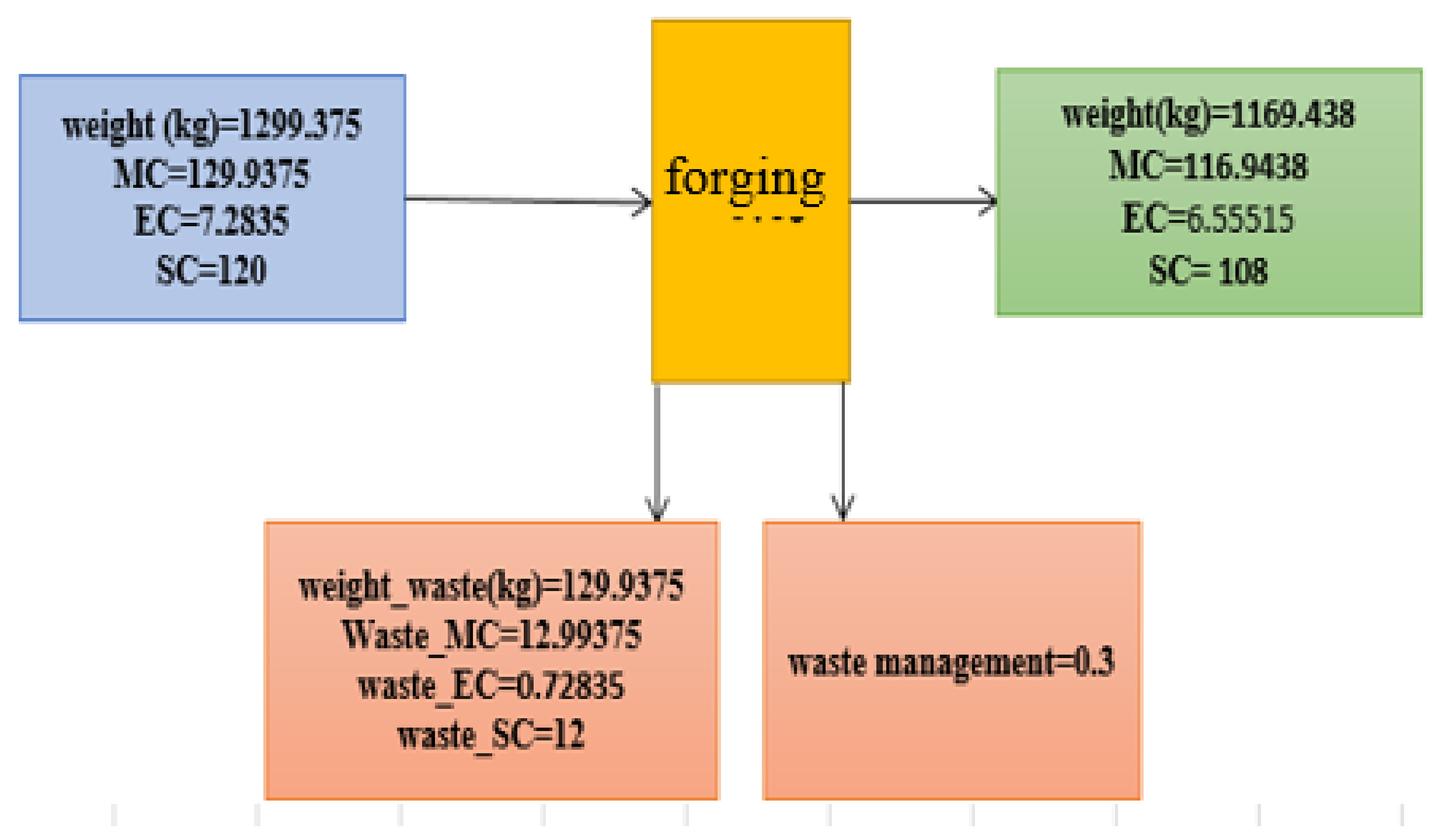
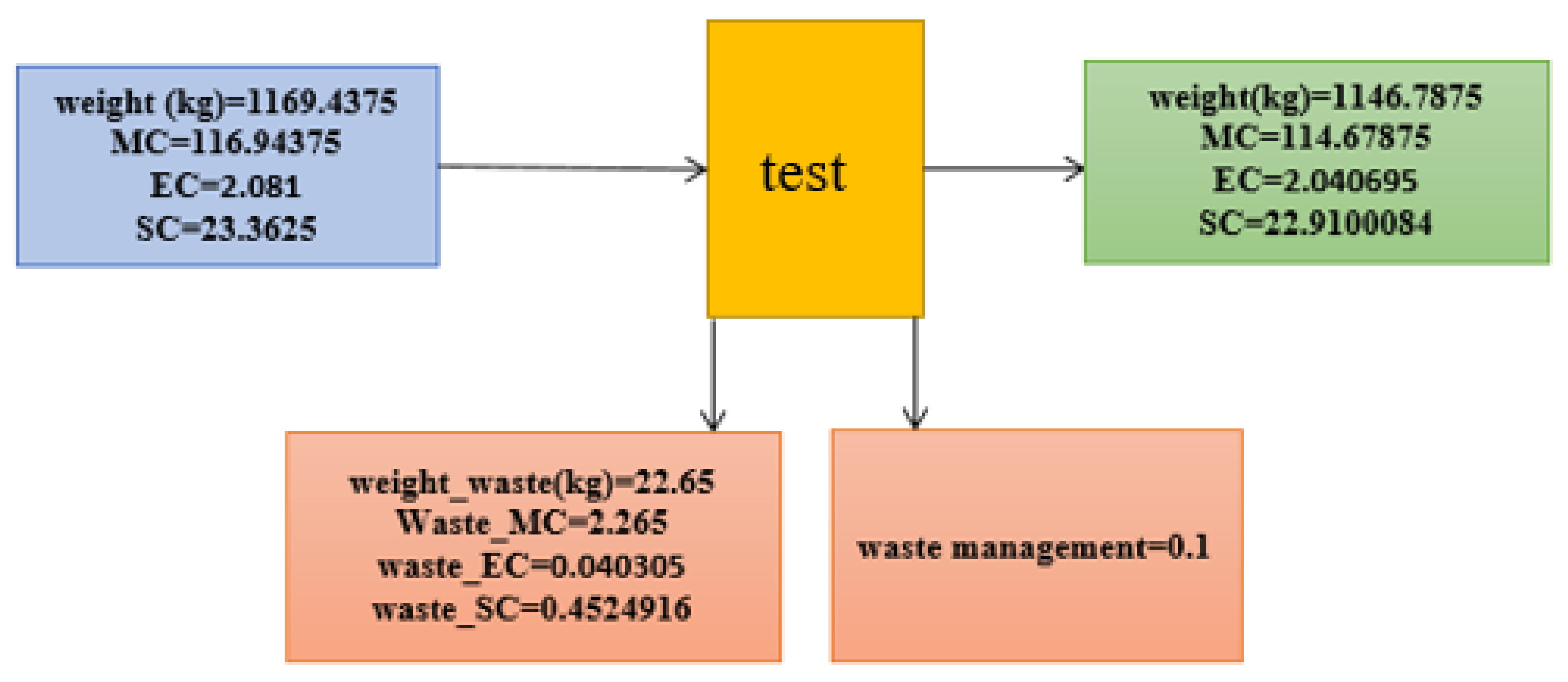
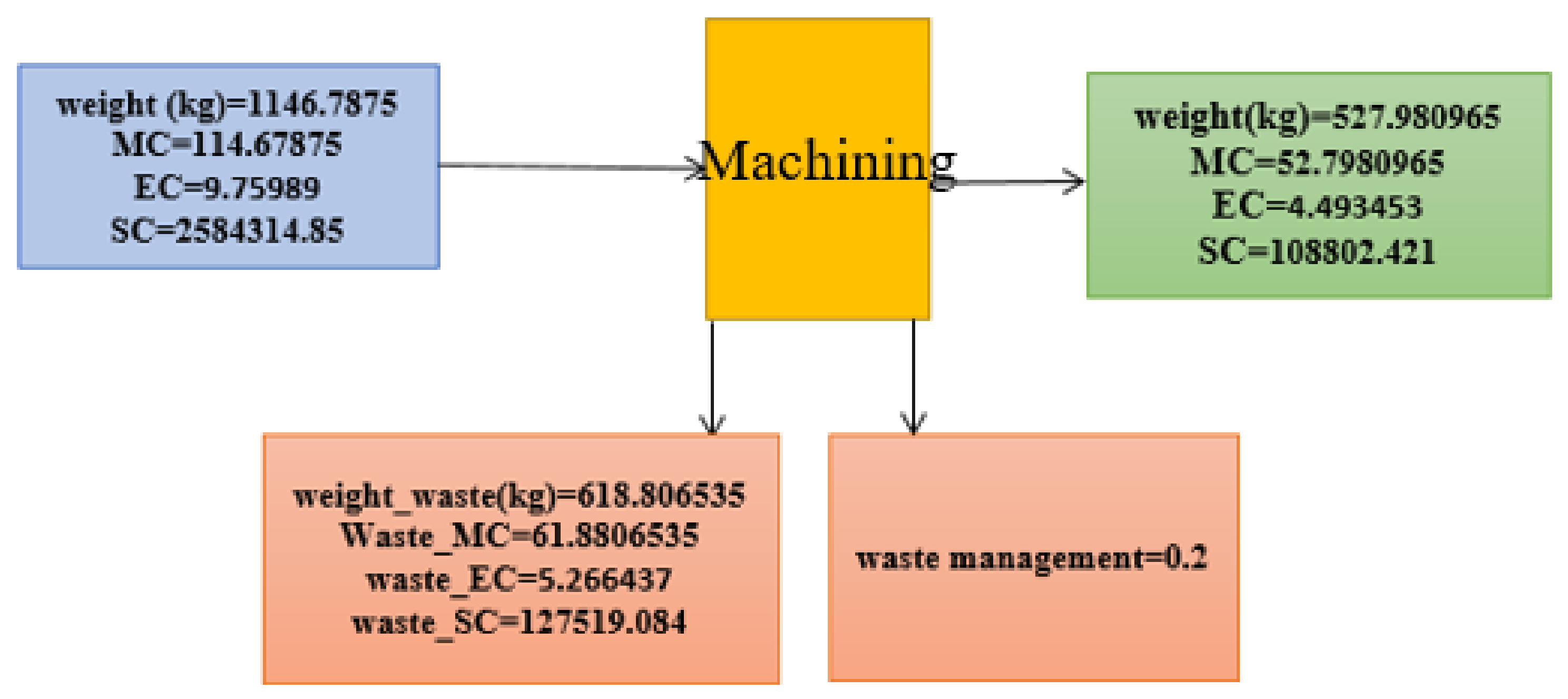
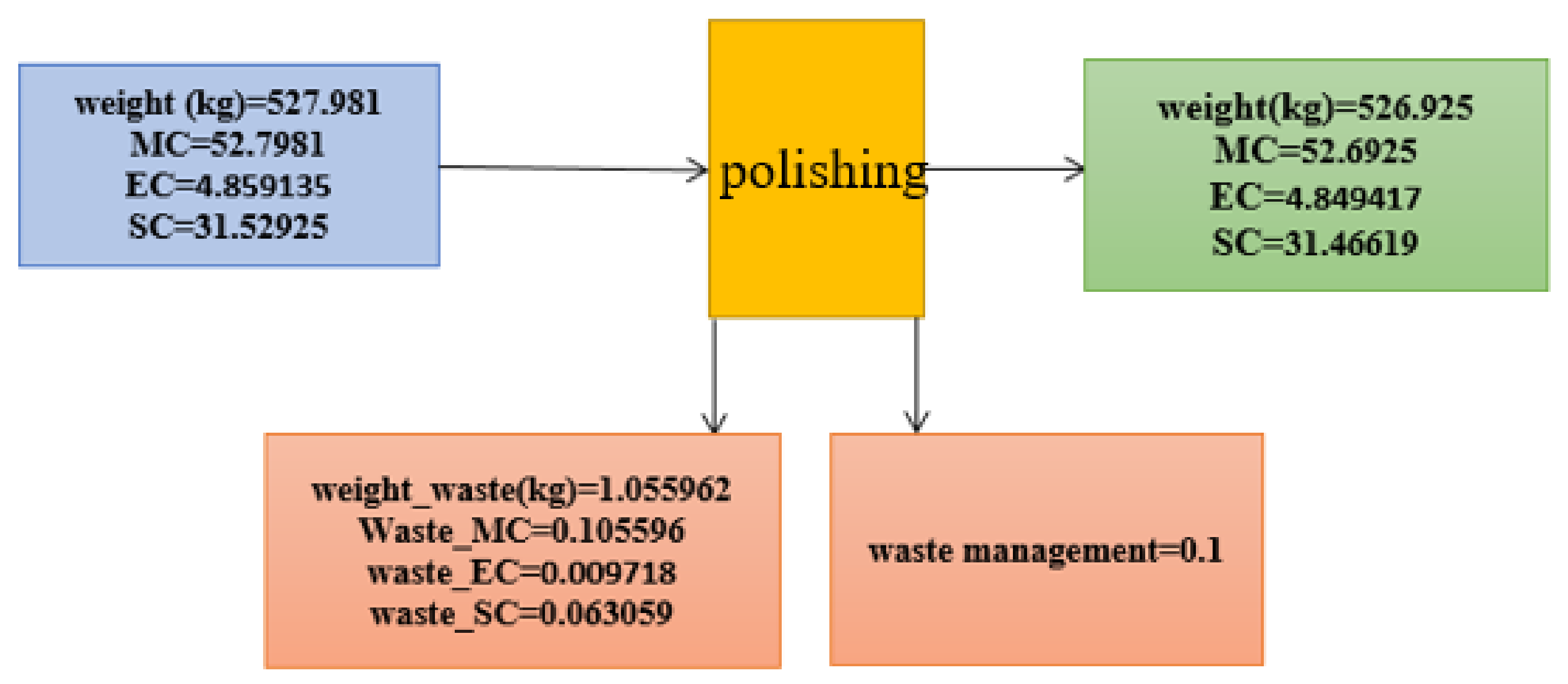
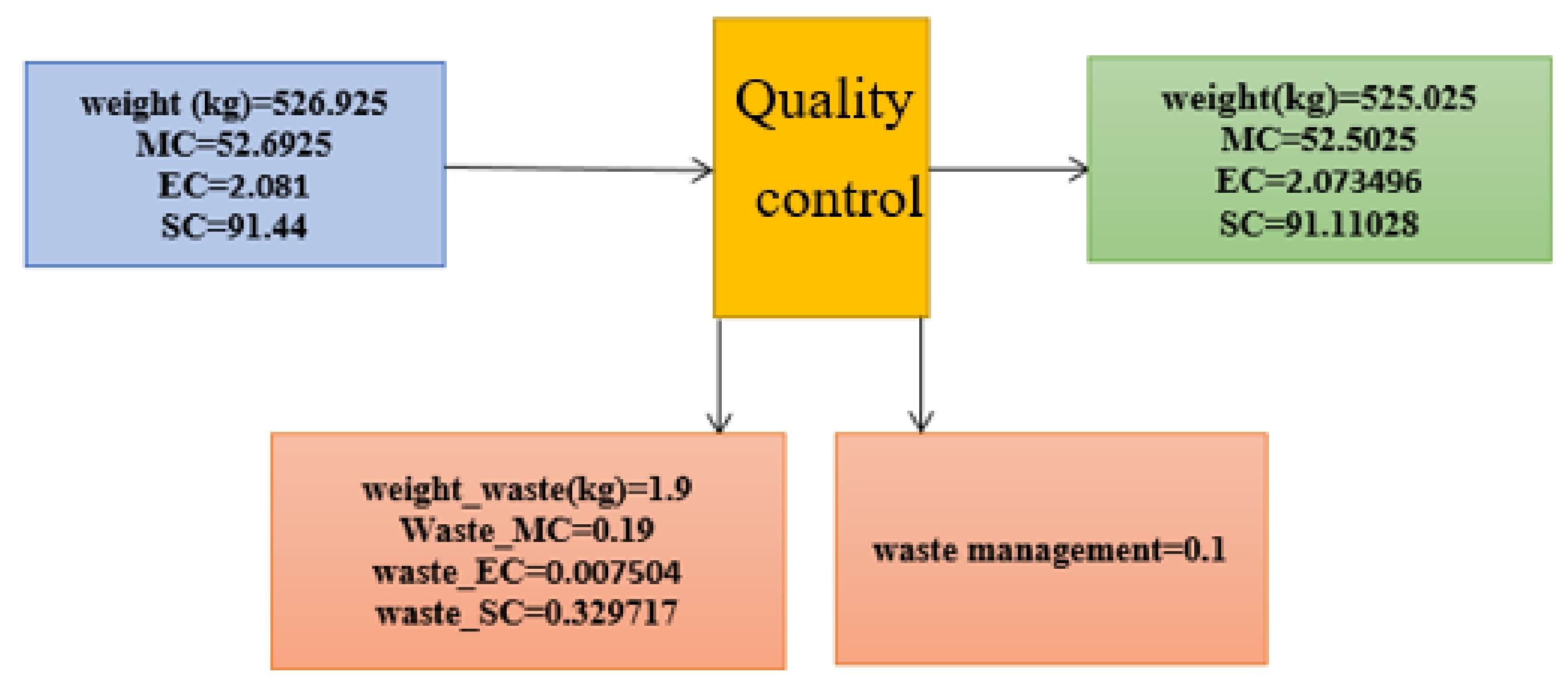
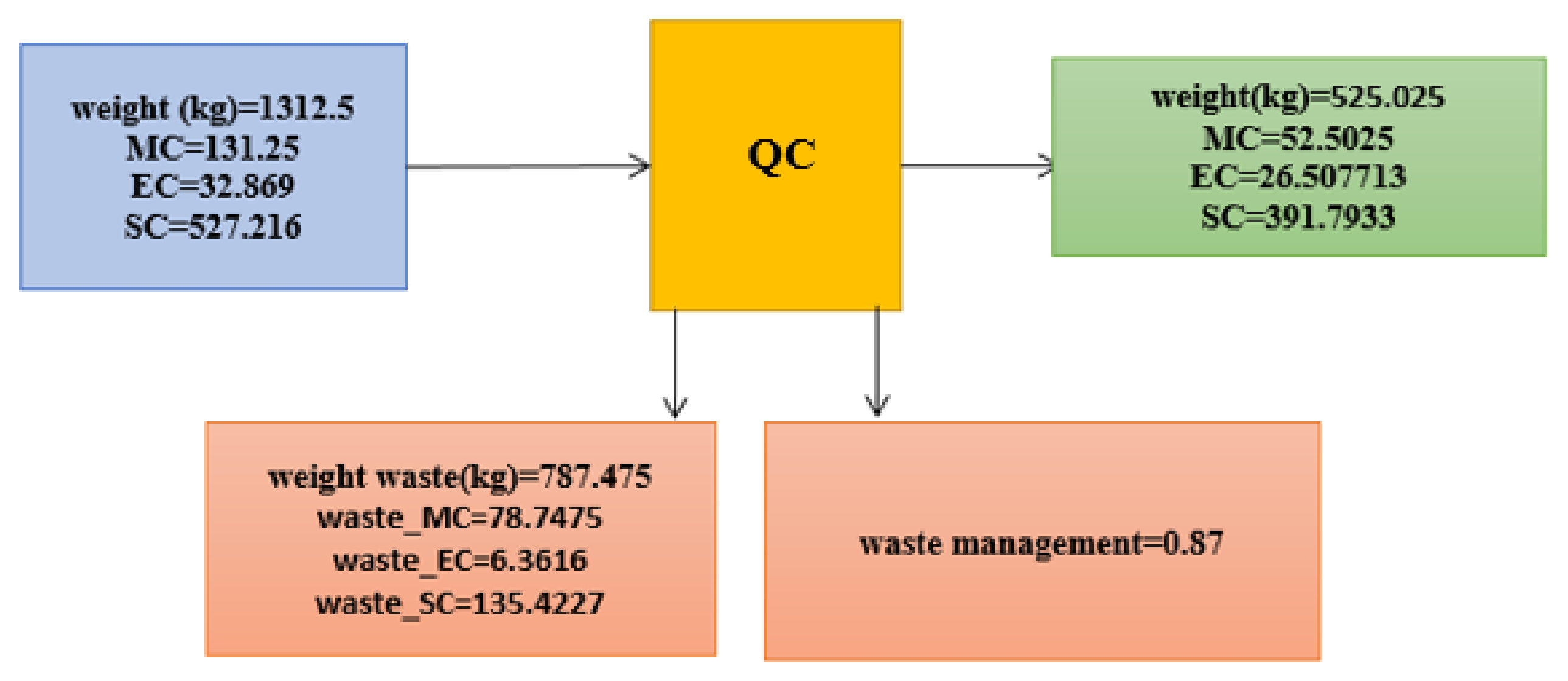
References
- IEA. Global Energy & CO2 Status Report; The International Energy Agency (IEA): Paris, France, 2019. [Google Scholar]
- Gong, J.W.; Li, Y.P.; Suo, C.; Lv, J. Planning regional energy system with consideration of energy transition and cleaner production under multiple uncertainties: A case study of Hebei province, China. J. Clean. Prod. 2020, 250, 119463. [Google Scholar] [CrossRef]
- Lambrecht, H.; Hottenroth, H.; Schröer, T.; Schulenburg, F. Optimization-aided material and energy flow analysis for a low carbon industry. J. Clean. Prod. 2017, 167, 1148–1154. [Google Scholar] [CrossRef]
- ISO. Environmental Management—Material Flow Cost Accounting General Framework; ISO 14051:2011; ISO: Geneve, Switzerland, 2011. [Google Scholar]
- Kokubu, K.; Tachikawa, H. Material Flow Cost Accounting: Significance and Practical Approach? In Handbook of Sustainable Engineering; Springer: Dordrecht, The Netherlands, 2013; pp. 351–369. [Google Scholar]
- Sygulla, R.; Gotze, U.; Bierer, A. Material Flow Cost Accounting: A Tool for Designing Economically and Ecologically Sustainable Production Processes. In Technology and Manufacturing Process Selection; Springer: London, UK, 2014; pp. 281–296. [Google Scholar]
- IRIB. Central Bank of the Islamic Republic of Iran Report, Review and Economic Report & Balance; IRIB: Tehran, Iran, 2021. [Google Scholar]
- Dekamin, M.; Barmaki, M. Implementation of material flow cost accounting (MFCA) in soybean production. J. Clean. Prod. 2019, 210, 459–465. [Google Scholar] [CrossRef]
- Yagi, M.; Kokubu, K. Waste decomposition analysis in Japanese manufacturing sectors for material flow cost accounting. J. Clean. Prod. 2019, 224, 823–837. [Google Scholar] [CrossRef]
- Christ, K.L.; Burritt, R.L. Material flow cost accounting: A review and agenda for future research. J. Clean. Prod. 2015, 108, 1378–1389. [Google Scholar] [CrossRef]
- Al-Qawasmi, A.R.; Tlili, I. Energy efficiency and economic impact investigations for air-conditioners using wireless sensing and actuator networks. Energy Rep. 2018, 4, 478–485. [Google Scholar] [CrossRef]
- Maji, I.K.; Sulaiman, C. Renewable energy consumption and economic growth nexus: A fresh evidence from West Africa. Energy Rep. 2019, 5, 384–392. [Google Scholar] [CrossRef]
- Behnami, A.; Benis, K.Z.; Shakerkhatibi, M.; Fatehifar, E.; Derafshi, S.; Chavoshbashi, M.M. Integrating data reconciliation into material flow cost accounting: The case of a petrochemical wastewater treatment plant. J. Clean. Prod. 2019, 218, 616–628. [Google Scholar] [CrossRef]
- Schmidt, M.; Spieth, H.; Haubach, C.; Kühne, C. Material flow cost accounting in variant production. In 100 Pioneers in Efficient Resource Management; Springer: Berlin/Heidelberg, Germany, 2019; pp. 126–129. [Google Scholar]
- Schmidt, M.; Nakajima, M. Material Flow Cost Accounting as an Approach to Improve Resource Efficiency in Manufacturing Companies. Resources 2013, 2, 358–369. [Google Scholar] [CrossRef]
- Khan, M.N.; Rizwan, M.; Islam, F. The Extent of Application of Standard Costing: A Comparison of Chinese and Pakistani Manufacturing Firms; Hailey College of Commerce, University of the Punjab: Lahore, Pakistan, 2016. [Google Scholar]
- Sygulla, R.; Bierer, A.; Götze, U. Material Flow Cost Accounting—Proposals for Improving the Evaluation of Monetary Effects of Resource Saving Process Designs. In Proceedings of the 44th CIRP Conference on Manufacturing Systems, Madison, WI, USA, 1–3 June 2011. [Google Scholar]
- Hyrslova, J.; Vagner, M.; Palasek, J. Material Flow Cost Accounting (MEFCA)—Tool For the Optimization of Corporate Production Processes. Bus. Manag. Educ. 2011, 9, 5–18. [Google Scholar] [CrossRef]
- Tang, X.; Takakuwa, S. MEFCA-Based Simulation Analysis for Enviroment-Oriented Scm Optimization Conducted by SMES. In Proceedings of the 2012 Winter Simulation Conference, Berlin, Germany, 9–12 December 2012. [Google Scholar]
- Doorasamy, M.; Garbharran, H. The effectiveness of using material flow cost accounting (MEFCA) to identify non-product output costs. Environ. Econ. J. 2015, 6, 70–82. [Google Scholar]
- Wang, Y.; Kuo, C.H.; Song, R.; Hu, A.H.; Zhang, S.S. Potentials for Improvement of Resource Efficiency in Printed Circuit Board Manufacturing: A Case Study Based on Material Flow Cost Accounting. Sustainability 2017, 9, 907. [Google Scholar] [CrossRef]
- Sahu, A.K.; Padhy, R.K.; Das, D.; Gautam, A. Improving financial and environmental performance through MFCA: A SME case study. J. Clean. Prod. 2021, 279, 1–19. [Google Scholar] [CrossRef]
- May, N.; Guenther, E. Shared benefit by Material Flow Cost Accounting in the food supply chain—The case of berry pomace as upcycled by-product of a black currant juice production. J. Clean. Prod. 2020, 245, 118946. [Google Scholar] [CrossRef]
- Echin, A.; Bondarenko, Y. Turbine blades production technique equipment built with a glance of high-gradient directional crystallization process nature. In MATEC Web of Conferences; EDP Sciences: Agoda, France, 2014; Volume 14, p. 13001. [Google Scholar]
- Torres-Carrillo, S.; Siller, H.R.; Vila, C.; López, C.; Rodríguez, C.A. Environmental analysis of selective laser melting in the manufacturing of aeronautical turbine blades. J. Clean. Prod. 2020, 246, 119068. [Google Scholar] [CrossRef]
- Turek, P.; Budzik, G.; Sęp, J.; Oleksy, M.; Józwik, J.; Przeszłowski, Ł.; Paszkiewicz, A.; Kochmański, Ł.; Żelechowski, D. An Analysis of the Casting Polymer Mold Wear Manufactured Using PolyJet Method Based on the Measurement of the Surface Topography. Polymers 2020, 12, 3029. [Google Scholar] [CrossRef] [PubMed]
- Ebrahimi, M.; Keshavarz, A. Combined Cooling, Heating and Power, Decision-Making, Design and Optimization, 1st ed.; Elsevier: Amsterdam, The Netherlands, 2014. [Google Scholar]
- Gopal, N.; Tiwari, L.S. Exergy and Technoeconomic Analysis of Solar Thermal Desalination. In Renewable Energy Powered Desalination Handbook: Application and Thermodynamics; Butterworth-Heinemann: Oxford, UK, 2018; Available online: https://www.sciencedirect.com/book/9780128152447/renewable-energy-powered-desalination-handbook. (accessed on 20 April 2021).
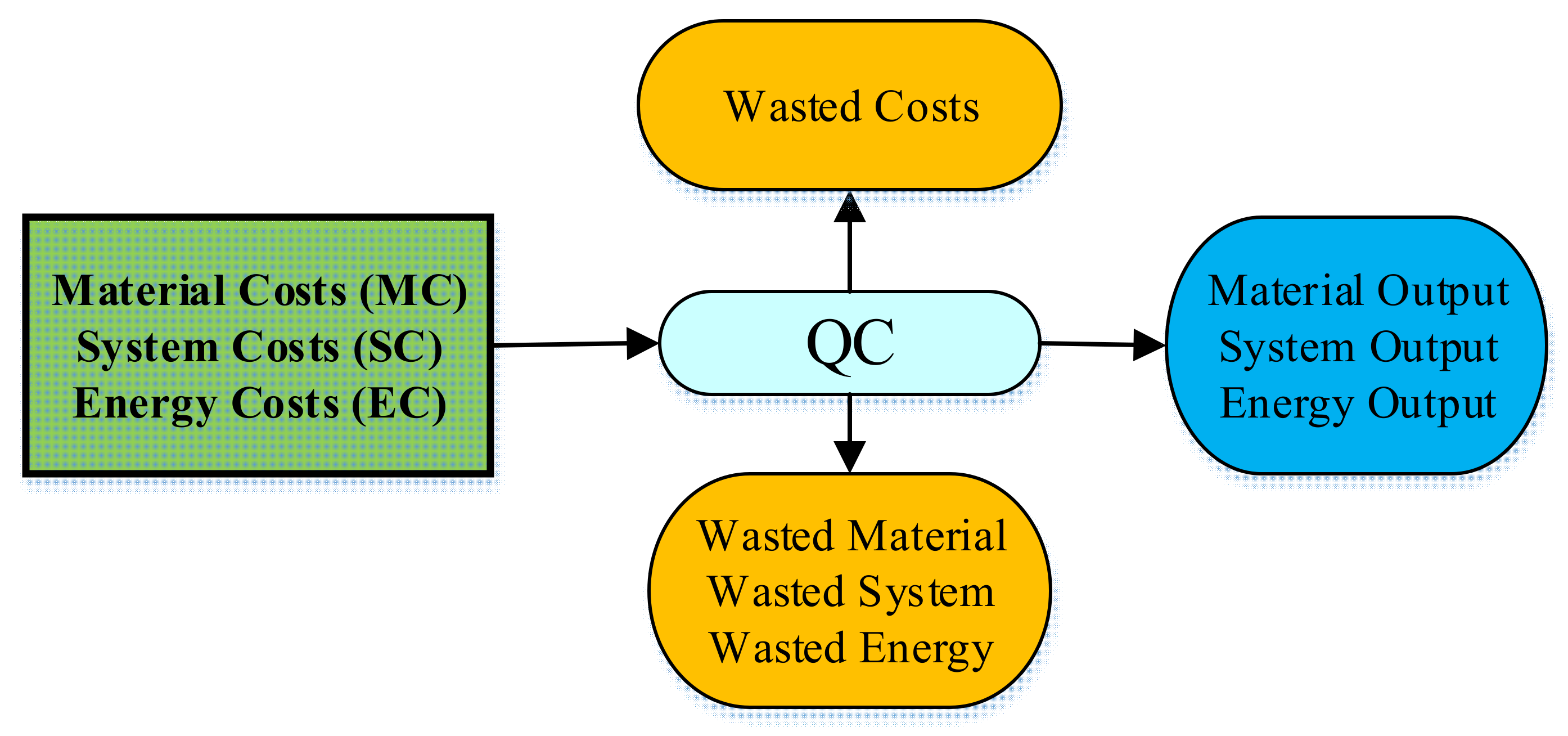



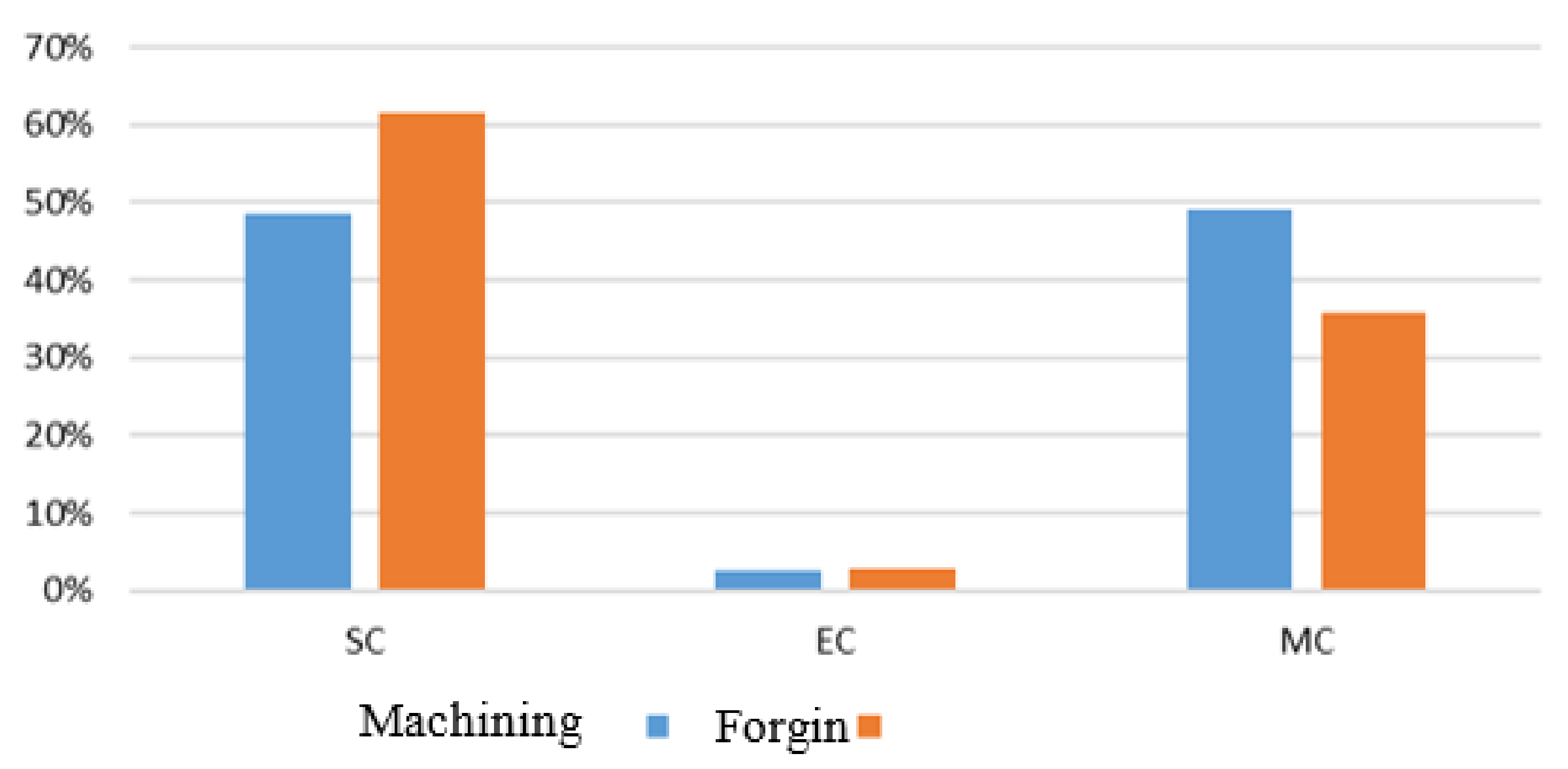

| Index | Symbol |
|---|---|
| input materials, system, and energy index | indexMC, IndexSC, IndexEC |
| input materials, system, and energy cost | CostMC, CostSC, CostEC |
| material weight and material waste | WMC, WW |
| materials, system, and energy waste cost | CostWM, CostWS, CostWE |
| materials, system, and energy positive output cost | CostPM, CostPS, CostPE |
| Process Step | Cost MC | Cost Energy | Cost SC | Negative MC Cost | Waste EC Cost | Waste SC Cost | Positive MC Cost | Positive EC Cost | Positive SC Cost | Waste Management |
|---|---|---|---|---|---|---|---|---|---|---|
| Cutting | 399.38 | 9.1 | 59.06 | 3.99 | 0.09 | 0.59 | 395.38 | 9.01 | 58.47 | 0.1 |
| Test | 395.38 | 3.12 | 36.17 | 2.58 | 0.02 | 0.24 | 392.81 | 3.1 | 35.93 | 0.1 |
| Machining | 392.81 | 19.74 | 393.47 | 340.01 | 17.09 | 340.58 | 52.79 | 2.65 | 52.88 | 0.5 |
| Polishing | 52.79 | 4.91 | 31.86 | 2.64 | 0.02 | 0.16 | 52.53 | 4.89 | 31.7 | 0.15 |
| Quality Control | 52.53 | 3.12 | 91.44 | 0.67 | 0.04 | 1.17 | 51.86 | 3.08 | 90.27 | 0.1 |
| Total | 399.38 | 40 | 612 | 347.52 | 17.26 | 342.74 | 51.86 | 22.74 | 269.26 | 0.95 |
| Process Step | Cost MC | Cost Energy | Cost SC | Negative MC Cost | Waste EC Cost | Waste SC Cost | Positive MC Cost | Positive EC Cost | Positive SC Cost | Waste Management |
|---|---|---|---|---|---|---|---|---|---|---|
| Cutting | 131.25 | 5.30 | 34.36 | 1.31 | 0.05 | 0.34 | 129.94 | 5.24 | 34.01 | 0.07 |
| Forging | 129.94 | 7.28 | 120.00 | 12.99 | 0.73 | 12.00 | 116.94 | 6.56 | 108.00 | 0.30 |
| Test | 116.94 | 2.08 | 23.36 | 2.27 | 0.04 | 0.45 | 114.68 | 2.04 | 22.91 | 0.10 |
| Machining | 114.68 | 10.23 | 226.53 | 61.88 | 5.52 | 122.23 | 52.80 | 4.71 | 104.29 | 0.20 |
| Polishing | 52.80 | 4.86 | 31.53 | 0.11 | 0.01 | 0.06 | 52.69 | 4.85 | 31.47 | 0.10 |
| Quality Control | 52.69 | 3.12 | 91.44 | 0.19 | 0.01 | 0.33 | 52.50 | 3.11 | 91.11 | 0.10 |
| Total | 131.25 | 32.87 | 527.22 | 78.75 | 6.36 | 135.42 | 52.50 | 26.51 | 391.79 | 0.87 |
| Process Method | Waste | Positive Output | Negative Output | Input | |||||||||
|---|---|---|---|---|---|---|---|---|---|---|---|---|---|
| WM | MC | MC (kg) | EC | SC | MC | EC | SC | MC (kg) | MC | EC | SC | MC (kg) | |
| Machining | 0.95 | 51.857 | 518.572 | 22.735 | 269.257 | 347.517 | 17.261 | 342.739 | 3475.178 | 399.375 | 39.996 | 611.997 | 3993.75 |
| Forging | 0.87 | 52.502 | 525.025 | 26.507 | 391.793 | 78.747 | 6.361 | 135.422 | 787.47 | 131.25 | 32.86 | 527.216 | 1312.5 |
| Improvement percentage | 8% | 1% | 1% | 17% | 46% | 77% | 63% | 60% | 77% | 67% | 18% | 14% | 67% |
| No. | Item | Amount |
|---|---|---|
| 1 | Production capacity of blades in one year | 15 sets |
| 2 | Average selling price | USD 0.6 million |
| 3 | Present value of machining equipment | USD 60 million |
| 4 | Service remaining life of machining equipment | 40 years |
| 5 | Sacrificial value of machining equipment | USD 4 million |
| 6 | The amount of capital needed to start a forging workshop | USD 4 million |
| 7 | Service life of forging equipment | 40 years |
| 8 | Sacrificial value of forging equipment | USD 0.2 million |
Publisher’s Note: MDPI stays neutral with regard to jurisdictional claims in published maps and institutional affiliations. |
© 2021 by the authors. Licensee MDPI, Basel, Switzerland. This article is an open access article distributed under the terms and conditions of the Creative Commons Attribution (CC BY) license (https://creativecommons.org/licenses/by/4.0/).
Share and Cite
Hakimi, A.; Abedi, Z.; Dadashian, F. Increasing Energy and Material Consumption Efficiency by Application of Material and Energy Flow Cost Accounting System (Case Study: Turbine Blade Production). Sustainability 2021, 13, 4832. https://doi.org/10.3390/su13094832
Hakimi A, Abedi Z, Dadashian F. Increasing Energy and Material Consumption Efficiency by Application of Material and Energy Flow Cost Accounting System (Case Study: Turbine Blade Production). Sustainability. 2021; 13(9):4832. https://doi.org/10.3390/su13094832
Chicago/Turabian StyleHakimi, Asghar, Zahra Abedi, and Fatemeh Dadashian. 2021. "Increasing Energy and Material Consumption Efficiency by Application of Material and Energy Flow Cost Accounting System (Case Study: Turbine Blade Production)" Sustainability 13, no. 9: 4832. https://doi.org/10.3390/su13094832
APA StyleHakimi, A., Abedi, Z., & Dadashian, F. (2021). Increasing Energy and Material Consumption Efficiency by Application of Material and Energy Flow Cost Accounting System (Case Study: Turbine Blade Production). Sustainability, 13(9), 4832. https://doi.org/10.3390/su13094832






